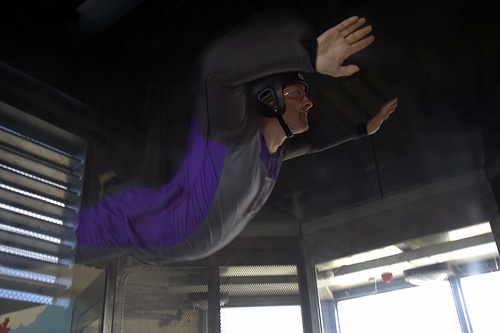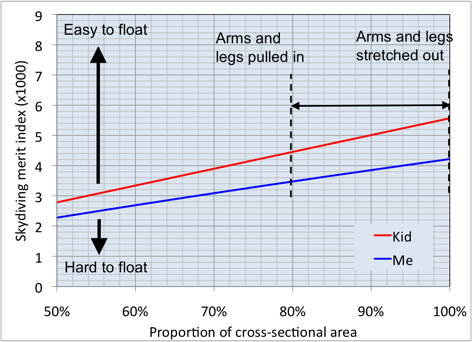I was lucky enough recently to visit a relative in California with a house above the San Francisco Bay. How excited was I when I realised I could see NASA Ames’ Moffett Airfield across the bay? This houses Hangar One, an old airship hanger like something out of Flash Gordon, and the World’s largest wind tunnel, used to test the Space Shuttle.

Flying inside a wind tunnel
One minute I was marvelling at a wind tunnel so big you can see it by eye from 15 miles away and the next, the family had dragged me away to fly in one. There is a fashion for indoor skydiving where you fly inside a vertical windtunnel tube around 4 m across and 20m high; you might have seen them from the motorway near Milton Keynes or Manchester. The one I flew in is driven by four 80 kW motors and the upwards force of the 160 mph wind on your body cancels out your body weight so that you hover in a similar fashion to free-falling at terminal velocity (i.e. at 160 mph) from a plane. Subtle adjustments to your hands and feet cause you to rotate or even tumble.

The instructor inside the working section, Brandon, and his pal outside in the control booth skillfully controlled the power of the loud fans to shoot fliers high into the vertical tube and then let them drop gently back down onto the floor of the safety cage. I noticed that the larger ones amongst us needed the fans on high and Brandon was pretty relaxed, letting us control our own ‘flight’. The kids, however, were gripped tightly as they almost rattled from side to side. The instructor showed off at the end doing fantastical loop-the-loops in the tight confines of the tube. The sportsman in me thought, why isn’t this in the Olympics? And then the science geek in me thought - what’s the physics of this? And what are the key influencing factors for a good performance?
The physics of indoor skydiving
If you are floating stationary so that the upward wind force and your downwards weight cancel out then the forces are in equilibrium. The ratio of these two forces reduce to cross-sectional-area/mass (see equations at end) and gives a merit index of how well you will float for a given wind speed; a high number means that it is easy for you to float and only a low wind speed is needed and vica versa. Working out your cross-sectional area is not the easiest thing to do but one way to guess if you know your height and weight is to use an equation create by Bassett et al. (1999) for cyclists. In fact, I am beginning to think that there is only one or two equations in sport of which the one for drag force is the key.
Once you’ve worked out how to calculate cross-sectional-area/mass, you find some interesting things. Let’s take a kid in our group - he was about 1.2 m (4 ft) tall and about 45 kg (100 1b) in mass - and compare him to me (1.93 m tall and 79 kg in mass). His merit index is 5.1 compared to my 4.6 so that he floats more easily and needs a lower wind speed to stay in the air.
The subtleties of flight are controlled by stretching your arms out and pulling them in: a bigger cross-sectional area makes you go up while a smaller one makes you drop. The graph below shows that the merit index drops when you pull your arms in so you float less easily. What is interesting about the difference between the kid and me, is that my merit index has both a lower value and also a lower gradient - this means that I am less susceptible to minute changes in my body posture and surface area. For the kid, however, not only is he likely shoot up into the wind tunnel if the wind speed is too high, but he is also less stable.

Skydiving in the Olympics?
So, is indoor skydiving a sport? Could it be in the Olympics? Of course, any physical skill soon leads to someone setting up a competition and certainly there seem to be plenty around, including one at the tunnel I used. And indoor skydiving is no more bizarre than some of our commonly accepted Olympic sports - fencing, diving, polevault, javelin, snowboard, bobsleigh…I could go on. In fact, the more I work in sport, the more bizarre it becomes since the challenges we set our Olympians are completely arbitrary. Let’s try indoor skydiving as a demonstration sport and see what happens (although you won’t see me winning anything on the performance I gave the other day).
Equations:
Drag, F:
F=½ρACdv²
where A is area, ρ is density, Cd is drag coefficient and v is air speed.
Area, A:
A=0.029H0.725m0.425+0.0604
where H is height in metres, m is mass in kg and A is cross-sectional-area in m².
The merit index M for the ease of flying in the windtunnel is given by the drag force divided by the weight mg where m is the mass and g is the acceleration due to gravity:
M=½ρACdv²/mg=(½ρACdv²/g)(A/m) α A/m
Reference:
Bassett, D. R. J., Kyle, C. R., Passfield, L., Broker, J. P. and Burke, E. R. (1999). Comparing cycling world hour records, 1967-1996: modelling with empirical data. Medicine and Science in Sports and Exercise, 31(11), 1665-1676.)





Red Bull makes hydrogen fuel cell play with AVL
Surely EVs are the best solution for motor sports and for weight / performance dispense with the battery altogether by introducing paired conductors...